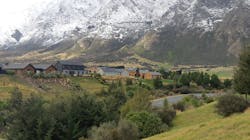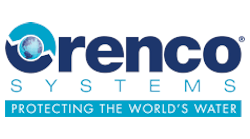New Zealand Puts Wastewater Out of Sight, Out of Mind at New Development
At the time of its conception in 2002, the Jack’s Point subdivision was set to become the largest planned residential community in New Zealand, with developers envisioning approximately 900 luxury homes. The selected location was just outside of Queenstown, a resort community on the shores of Lake Wakatipu with a view of the snow-capped Southern Alps.
The development would include a clubhouse (with a restaurant, pro shop, and offices), a golf course, and 25 km (15.5 miles) of walking and biking trails. Every detail of construction would be focused on maintaining and enhancing the natural environment, while offering the comforts and conveniences of city living.
One of those conveniences is reliable wastewater treatment. But local sewer service was over 8 km (4.9 miles) away, and the existing municipal wastewater treatment plant would require an upgrade to accommodate the additional flow generated by Jack’s Point.
With these circumstances in mind, developers looked for adaptable wastewater collection and treatment solutions. They needed an economically sustainable collection system that could handle variable terrain, followed by a reliable treatment system that would produce high-quality effluent and could be installed in stages, with minimal visual impact on the community.
A Winning Combination
During the bidding process, Innoflow Technologies put forth a design-build-operate proposal that incorporated an Orenco® liquid-only sewer, AdvanTex® secondary wastewater treatment, and subsurface drip irrigation. This proposal was ultimately accepted by the developer and later approved by the Otago Regional Council, which issued the Resource Consent (discharge permit).
“[We] undertook an options assessment for Jack’s Point sewerage systems and considered at least three package plant options and three reticulation options,” Rob Potts of Lowe Environmental Impact, one of the project engineers says. “The effluent [liquid-only] sewer option was selected due to the shallow depth to bedrock and undulating nature of the terrain, as it allowed the sewer to follow the contour of the land. It was selected above a pressure sewer system due to the lower overall whole-of-life operating costs.”
In a paper presented at the 2006 Annual Conference of the New Zealand Land Treatment Collective, Potts and his fellow project engineer, Ken Gousmett, cited the unique advantages of a liquid-only sewer installation.
“Use of interceptor tanks at individual residential lots has advantages over traditional raw sewage gravity flow and pump station systems, which are more difficult to engineer over undulating ground with shallow bedrock (as is the case at Jack’s Point). Effluent is pretreated and can be easily pumped though small diameter pipes installed in a common service trench to the wastewater treatment plant. Sludge production at the treatment plant is reduced and there is greater capacity in the system to store wastewater if a breakdown occurs,” Potts and Gousmett wrote.
Developers favored Orenco’s AdvanTex AX-100 technology for its simplicity, low operation and maintenance, tolerance for varied hydraulic loads, and ability to expand in stages.
“The textile treatment system is modular and can be installed incrementally as development within the residential zones progresses. Other technologies considered (sequencing batch reactors, other aerated systems) require higher levels of operator input, produce significant quantities of sludge that require disposal and are not as robust with regard to treating varying hydraulic loadings,” Potts and Gousmett continued.
Before the regional council would grant the Resource Consent, it wanted assurance that post-development nutrient content (particularly nitrogen) would be significantly less than it was pre-development. Innoflow was able to demonstrate through effluent testing at similar sites that the AdvanTex system could meet the required nitrogen limits.
Initially, developers had been concerned about the visual impact of the treatment facilities. But once they saw how low to the ground the first treatment units were installed, their concerns were put to rest. Operations management at Jack’s Point report that the facilities — known to minimize odor and sound — have not garnered any complaints, despite their proximity to homes and recreation facilities in the community.
Treated effluent from the AdvanTex units is used to irrigate nearby fields, some of which are used for grazing sheep. The fields are also cropped at least once a year, and the hay is used as fodder. Because of the strict limits on nitrogen, the number of bales produced each year is used in nitrogen mass-balance calculations.
Jack’s Point Today
The community is roughly divided into seven neighborhoods (N1-N7). The clubhouse has a 9,000 L (about 2,400-gallon on-lot tank, while each house has a 3,800 L (about 1,000 gallon) tank. Primary treated effluent is pumped from these tanks through small-diameter, liquid-only sewer lines to one of the subdivision’s three AdvanTex wastewater treatment facilities. Treated effluent is dispersed through subsurface, pressure-compensating driplines into the irrigation fields.
The development is still growing, with a current total of 484 connections. The total treatment capacity will max out at 750 homes, but if additional treatment capacity is added, the Resource Consent allows for up to 1,430 homes. As of May 2020, Facility #1 (serving N1 and N4, plus the clubhouse) includes 258 homes completed with 382 possible connections; Facility #2 (serving N2 and N3) includes 93 homes completed with 164 possible connections; and Facility #3 (serving N5, N6, and N7) includes 133 homes completed with 182 possible connections.
The three treatment systems are being upgraded one by one to enhance nutrient reduction, and further development that would connect to one of the existing treatment facilities is planned.
“The selected system is still considered the optimal type of system for this development, as it is still progressing, some 20 years later,” Potts says. “If we had to redo the option assessment, we believe that we would still arrive at the same solution.” WW
About the Authors: Bill Hensley is the senior systems engineer for the international department at Orenco Systems Inc.
Jennifer Wimber is a senior writer at Orenco.
Published in WaterWorld Magazine, April 2022.




